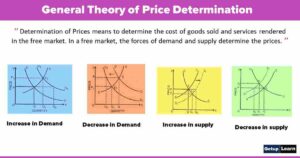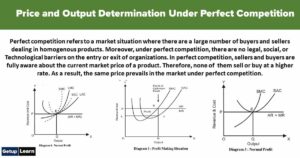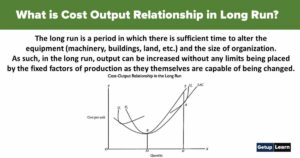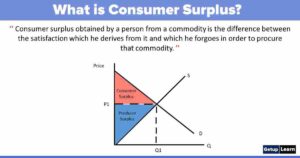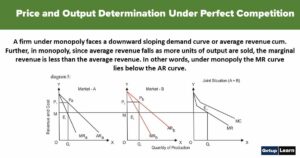Table of Contents
- 1 What is Production Function?
- 2 Importance of Production Function
- 3 Assumptions of Production Function
- 4 Features of Production Function
- 5 Types of Production Function
- 6 Short Run Production Function
- 7 Law of Increasing Returns
- 8 Law of Constant Returns
- 9 Law of Diminishing Returns
- 10 Law of Variable Proportions
- 11 Importance of Law of Diminishing Returns in Production
- 12 Long Run Production Function
- 13 FAQ Related to Production Function
What is Production Function?
Production is a process of transforming tangible and intangible inputs into goods or services. Raw materials, land, labour and capital are the tangible inputs, whereas ideas, information and knowledge are the intangible inputs. These inputs are also known as factors of production.

Table of Contents
For an organisation, the four major factors of production are land, capital, labour and enterprise. An organisation needs to make optimum utilisation of these factors to achieve maximum output. The technical relationship between the inputs and the output is expressed by the production function. It enables an organisation to achieve maximum output with the given combinations of factors of production in a particular time period.
The basic relationship between the factors of production and the output is referred to as a Production Function. The firm’s production function for a particular good (q) shows the maximum amount of the good that can be produced using alternative combinations of capital (K) and labour (L) The production function expresses a functional relationship between physical inputs and physical outputs of a firm at any particular time period. The output is thus a function of inputs. Mathematically production function can be written as Q= f (L1, L2, C,O,T).
Where “Q” stands for the quantity of output and L1, L2, C,O,T are various input factors such as land, labour, capital and organization and technology. Here the output is the function of inputs. Hence output becomes the dependent variable and inputs are the independent variables. It is a technical relation that connects factors inputs used in the production function and the level of outputs.
Q = f (Land, Labour, Capital, Organization, Technology, etc) The above function does not state by how much the output of “Q” changes as a consequence of change of variable inputs. In order to express the quantitative relationship between inputs and output, Production function has been expressed in a precise mathematical equation i.e.
Y= a+b (x)
Which shows that there is a constant relationship between applications of input (the only factor input ‘X’ in this case) and the amount of output (y) produced.
Importance of Production Function
These are important of production functions which are given below:
- When inputs are specified in physical units, the production function helps to estimate the level of production.
- It becomes is equates when different combinations of inputs yield the same level of output.
- It indicates the manner in which the firm can substitute one input for another without altering the total output.
- When the price is taken into consideration, the production function helps to select the least combination of inputs for the desired output.
- It considers two types of input-output relationships namely ‘law of variable proportions and ‘law of returns to scale. The Law of variable propositions explains the pattern of output in the short run as the units of variable inputs are increased to increase the output. On the other hand law of returns to scale explains the pattern of output in the long run as all the units of inputs are increased.
- The production function explains the maximum quantity of output, which can be produced, from any chosen quantities of various inputs or the minimum quantities of various inputs that are required to produce a given quantity of output.
Assumptions of Production Function
Following are important assumptions of production function:
- Production function is related to a specific time period.
- The state of technology is fixed during this period of time.
- The factors of production are divisible into the most viable units.
- There are only two factors of production, labour and capital.
- Inelastic supply of factors in the short-run period. The uses of the production function are as follows:
- Helps in making short-term decisions, such as optimum level of output.
- Helps in making long-term decisions, such as deciding the production level.
- Helps in calculating the least-cost combination of various factor inputs at a given level of output.
- Gives logical reasons for making decisions. For example, if the price of one input falls, one can easily shift to other inputs. Apart from the advantages, the production function also suffers from some limitations, which are given as follows:
- Restricts itself to the case of two inputs and one output.
- Assumes a smooth and continuous curve, which is not possible in the real world, as there are always discontinuities in production.
- Assumes technology as fixed, which is not possible in the real world.
- Assumes a perfectly competitive market, which is rare in the real world.
Features of Production Function
The production function is the input-output relationship with a given state of technology and it is concerned with the short run as well as the long run. It has the following salient features:
- Production function studies the physical quantities of inputs and physical quantities of output. It is not concerned with monetary calculations.
- The production function is totally independent of the prices of inputs and output. In actual practice, the production decisions of an individual firm are based on the prices of inputs and output.
- The study of production function is based on the assumption that the technical know-how is given. If the technology goes under change the production function will also change.
- The production function is concerned with a given period of time. Different periods of time have different types of the production functions.
- Under production function, one input can be substituted by another input and more or fewer units of these inputs can be employed.
- When an Individual firm employs one factor of production as fixed (land) and other inputs are kept variable during short period the production function is called the short-run production function.
- In long run all the factors of production are variable. When an individual operates its production in such a situation it is called the long-run production function.
- Production function studies the given techniques of production during the short run as well as the long run.
Types of Production Function
These two types of production function relationships have been explained in the form of laws:
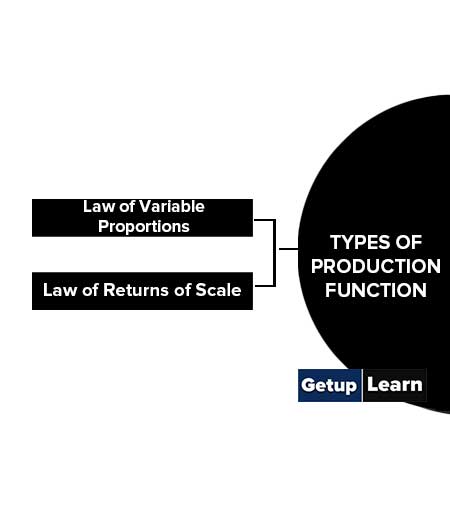
Law of Variable Proportions
The law of variable proportions which is a new name given to the old classical concept of “Law of diminishing returns has played a vital role in modern economic theory. Assume that a firm production function consists of fixed quantities of all inputs (land, equipment, etc.) except labour which is a variable input when the firm expands output by employing more and more labour it alters the proportion between fixed and variable inputs.
The law can be stated as follows: “When total output or production of a commodity is increased by adding units of a variable input while the quantities of other inputs are held constant, the increase in total production becomes after some point, smaller and smaller”.
“If equal increments of one input are added, the inputs of other production services being held constant, beyond a certain point the resulting increments of the product will decrease i.e. the marginal product will diminish”. (G. Stigler).
“As the proportion of one factor in a combination of factors is increased, after a point, first the marginal and then the average product of that factor will diminish”. (F. Benham).
The law of variable proportions refers to the behaviour of output as the quantity of one Factor is increased Keeping the number of other factors fixed and further, it states that the marginal product and average product will eventually do cline. This law states three types of productivity an input factor – Total, average and marginal physical productivity.
Assumptions of Law of Variable Proportions
Assumptions of law of variable proportions are based upon the following assumptions:
- The state of technology remains constant. If there is any improvement in technology, the average and marginal output will not decrease but increase.
- Only one factor of input is made variable and other factors are kept constant. This law does not apply to those cases where the factors must be used in rigidly fixed proportions. iii) All units of the variable factors are homogenous.
Stages of Law of Variable Proportions
The behaviours of the Output when the varying quantity of one factor is combined with a fixed quantity of the other can be divided into three district stages. The three stages can be better understood by following the table:
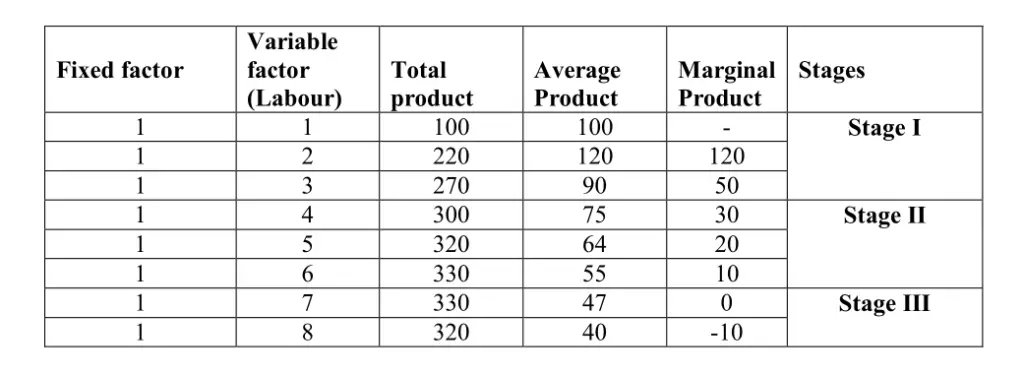
The above table reveals that both average product and marginal product increase in the beginning and then decline of the two marginal products drops off faster than average product. Total product is maximum when the farmer employs 6th worker, nothing is produced by the 7th worker and its marginal productivity is zero, whereas the marginal product of 8th worker is ‘-10’, by just creating credits 8th worker not only fails to make a positive contribution but leads to a fall in the total output.
Production function with one variable input and the remaining fixed inputs is illustrated below:
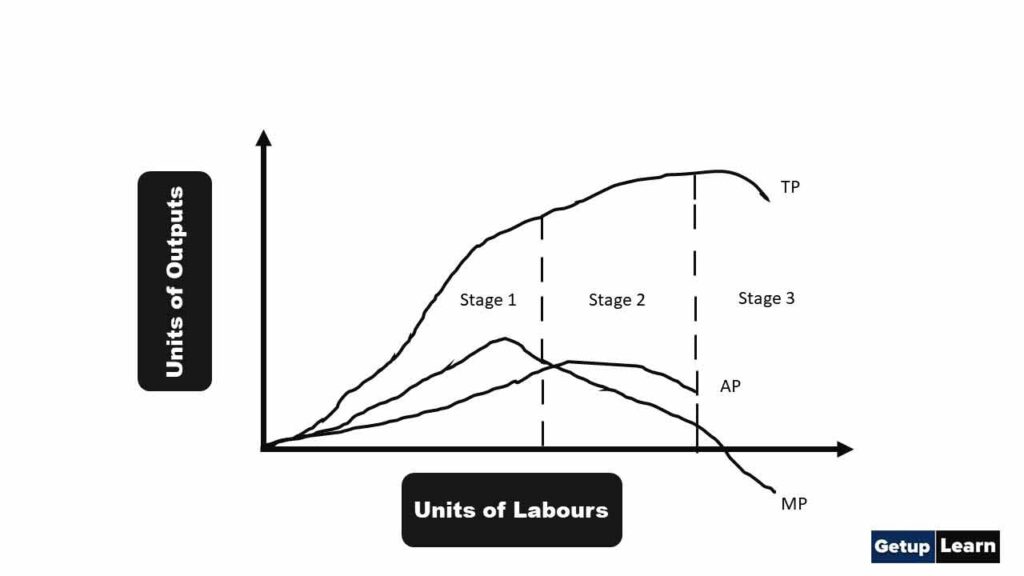
From the above graph the law of variable proportions operates in three stages:
- First Stage
- Second Stage
- Third Stage
First Stage
In the first stage, the total product increases at an increasing rate. The marginal product in this stage increases at an increasing rate resulting in a greater increase in total product. The average product also increases. This stage continues up to the point where the average product is equal to the marginal product.
The law of increasing returns is in operation at this stage. The law of diminishing returns starts operating from the second stage awards. At the second stage total product increases only at a diminishing rate. The average product also declines.
Second Stage
The second stage comes to an end where the total product becomes maximum and the marginal product becomes zero.
Third Stage
The marginal product becomes negative in the third stage. So the total product also declines. The average product continues to decline.
We can sum up the above relationship thus when ‘A.P.’ is rising, “M. P.’ rises more than “ A. P; When ‘A. P.” is maximum and constant, ‘M. P.’ becomes equal to ‘A. P.’ when ‘A. P.’ starts falling, ‘M. P.’ falls faster than ‘ A. P.’Thus, the total product, marginal product and average product pass through three phases, viz., increasing diminishing and negative returns stage. The law of variable proportion is nothing but the combination of the law of increasing and demising returns.
Law of Returns of Scale
The law of returns to scale explains the behaviour of the total output in response to change in the scale of the firm, i.e., in response to simultaneous changes in the scale of the firm, i.e., in response to a simultaneous and proportional increase in all the inputs.
More precisely, the Law of returns to scale explains how a simultaneous and proportionate increase in all the inputs affects the total output at its various levels. When a firm expands, its scale increases all its inputs proportionally, then technically there are three possibilities.
- The total output may increase proportionately.
- The total output may increase more than proportionately.
- The total output may increase less than proportionately.
Types of returns to scale
-
Increasing Return to Scale: If increase in the output is greater than the proportional increase in the inputs, it means increasing return to scale.
-
Constant returns to scale: If increase in the total output is proportional to the increase in input, it means constant returns to scale.
- Diminishing Returns to Scale: If increase in the output is less than proportional increase in the inputs, it means diminishing returns to scale.

Short Run Production Function
When a firm changes its production keeping a factor of production fixed and other factors of production variable during short period, it is called short run production function. Laws of returns are of three types as given below:
- Law of Increasing Returns
- Law of Constant Returns
- Law of Diminishing Returns
- Law of Variable Proportions
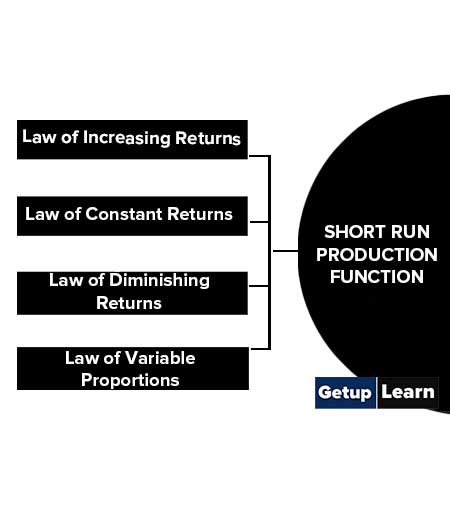
Law of Increasing Returns
According to this law of production when few inputs are kept fixed and other variable factors of production are changed, with the increase in the units of variable factors, the total production increases at an increasing rate i.e Marginal product increase.
The law of increasing returns will only apply when there is an increase in the factors of production leading to improvement in the efficiency of the firm or inputs. The operation of the law can be explained with the help of a table as given below:
Law of Increasing Returns (Production in Quintals)
| Units of Variable Inputs (Labour & Capital) | Total Production (TP) | AverageProduction (AP) | Marginal Production (MP) |
| 1. | 30 | 30 | 30 |
| 2. | 80 | 40 | 50 |
| 3. | 150 | 50 | 70 |
| 4. | 240 | 60 | 90 |
| 5. | 350 | 70 | 110 |
The table shows that with the increase in the units of variable inputs the total physical product increases with the increasing rate because marginal and average products are also increasing. The table can be shown in the form of a diagram as given below: Diagram shows that with the increase in variable inputs the AP and MP are increasing.
Law of Increasing Returns Diagram
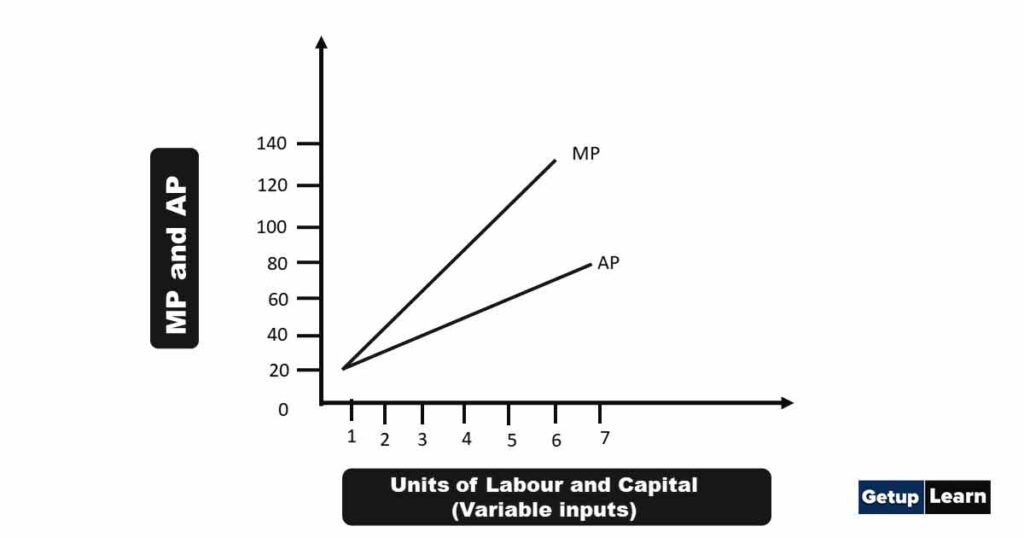
Causes of Application of Law of Increasing Returns
The law of increasing returns operates due to the following reasons:
Indivisibility of Inputs
Some factors of production are indivisible. These inputs are used in complete units and not in pieces. For example, a machine cannot be divided into pieces. As the variable inputs are increased the maximum utilisation of such indivisible input is made possible and consequently, the resultant output will be more than in proportion to the change in variable inputs. The law of increasing returns will operate.
Economies of Large Scale Production
As the scale of production increases the firms will enjoy internal and external economies of large scale production. Internal economies are concerned with the size and operation of the individual firm in the form of managerial, technical, marketing and specialisation economies.
External economies in the form of availability of cheap labour, power, water, market, means of communication and transportation, banking and financial institutions, raw material etc. will be available in an area where industrial units are set up. These internal and external economies of large scale production will lead to the operation of the law of increasing returns.
Optimum Use of Resources
The law of increasing returns applies on account of the optimum use of fixed and variable inputs. The supply of inputs is adequate and the optimum combination of inputs is attained by the producer and the law of increasing returns will operate in such a situation.
Maximum Utilisation of Installed Capacity – When a firm utilises its maximum installed capacity then the production will increase more than in proportion to the change in variable factors of production during a short period.
Law of Constant Returns
When the Average and Marginal production of a firm remains constant when the units of variable inputs are changed keeping the units of a fixed input constant, the operating law is called the law of constant returns during a short period. This law is the mid-point between the law of increasing returns and the law of diminishing returns.
Definition of Law of Constant Returns
[su_quote cite=”Professor Alfred Marshall“]If the actions of the laws of increasing and diminishing returns are balanced, we have the law of constant returns.[/su_quote]
[su_quote cite=”Professor Stigler“]When all the productive services are increased in a given proportion, the product is increased in the same proportion.[/su_quote]
Thus, we can say that the law of constant returns applies when the law of increasing returns stop and the law of diminishing returns does not operate.
The law can be explained with the help of a table showing total product (TP), Average Product (AP) and marginal product (MP), when the units of variable inputs (labour and capital) are changed keeping other fixed inputs constant as given below:
Law of Constant Returns (Output in Quintals)
| Units of Variable inputs (Labour & Capital) |
Total Production (TP) | AverageProduction (AP) | Marginal Production (MP) |
| 1. | 20 | 20 | 20 |
| 2. | 40 | 20 | 20 |
| 3. | 60 | 20 | 20 |
| 4. | 80 | 20 | 20 |
| 5. | 100 | 20 | 20 |
The table reveals that change in variable inputs by one unit change the TP by 20 quintals and AP and MP are also 20 quintals. It is the operation of the law of constant returns. The law of constant returns can be shown in the diagram as given below:
Output (AP and MP) is shown on OY-axis while units of variable inputs are shown on OX-axis in the diagram. 2 Both are constant and equal with the change in the units of variable inputs.
Law of Constant Returns Diagram
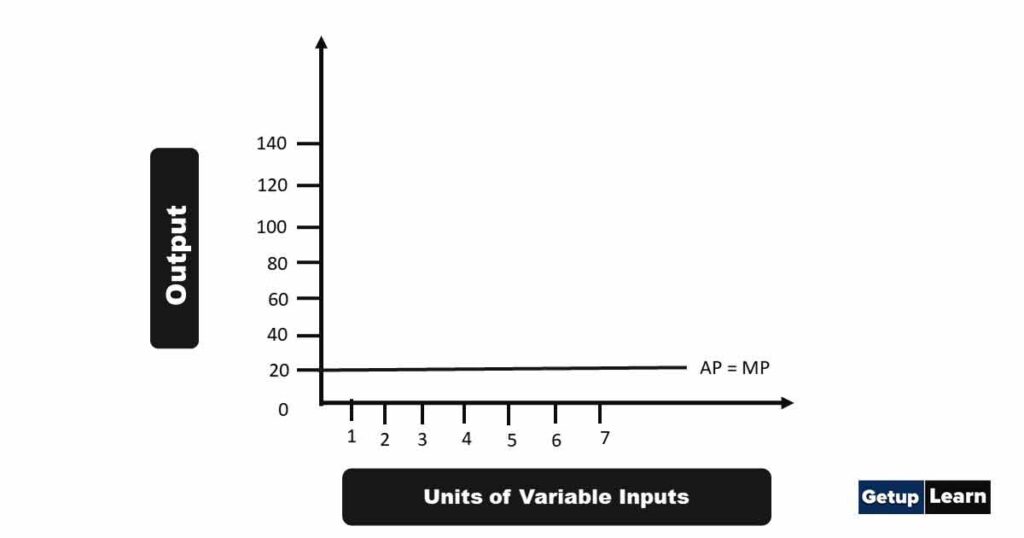
Law of Diminishing Returns
When the total output of a business firm increases in a lesser rate with every increase in the units of variable inputs keeping other fixed inputs constant, the law is called the law of diminishing returns.
Definition of Law of Diminishing Returns
[su_quote cite=”Professor Alfred Marshall”]“An increase in capital and labour applied in the cultivation of land causes in general a less than proportionate increase in the amount of produce raised unless it happens to coincide with an improvement in the art of agriculture.”[/su_quote]
[su_quote cite=”Mrs. Joan Robinson”]“The law of diminishing returns, as it is usually formulated, states that with a fixed amount of any one factor of production, successive increases in the number of other factors will after, yield a diminishing increment of the product.”[/su_quote]
Thus, the above definitions clearly reveal that the change in the units of variable inputs lead to change in the output less than in proportion and consequently the marginal product declines. The law of diminishing returns can be explained with the help of the following table:
Law of Diminishing Returns (Output in Quintals)
| Units of Variable inputs (Labour & Capital) |
Total Production (TP) | AverageProduction (AP) | Marginal Production (MP) |
| 1. | 10 | 10 | 10 |
| 2. | 18 | 9 | 8 |
| 3. | 24 | 8 | 6 |
| 4. | 28 | 7 | 4 |
| 5. | 30 | 6 | 2 |
The table shows that AP and MP are decreasing with the rising trends in TP. MP is falling more than the AP (AP>MP). It can also be shown in the diagram given below:
Law of Diminishing Returns Diagram
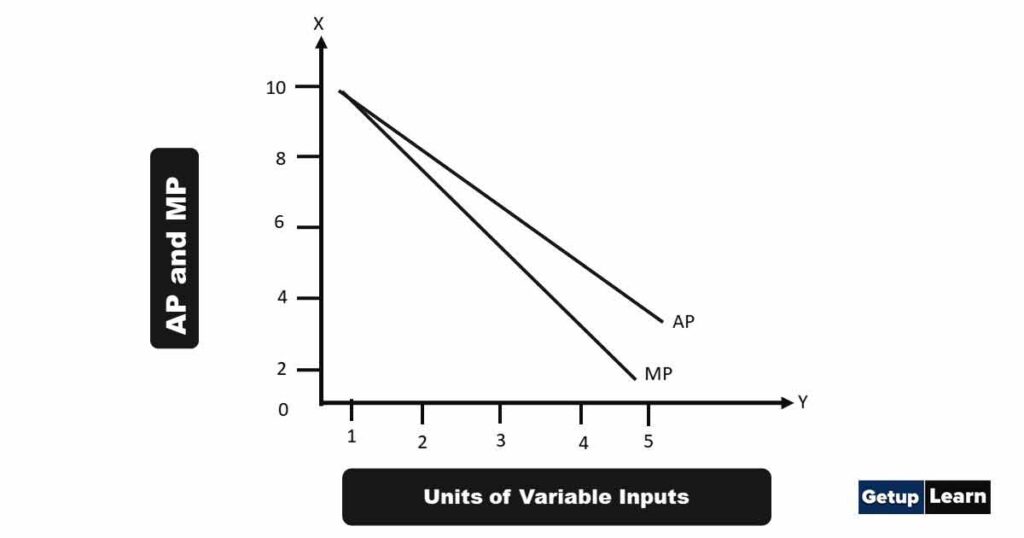
AP and MP are shown on OY-axis while units of variable inputs are shown on OX-axis. Both AP and MP are falling with the change in the units of variable inputs.
Law of Variable Proportions
Modern Version of the Law: Law of Variable Proportions,
Law of Variable Proportions Definition
[su_quote cite=”Prof. Alfred Marshall”]The law of diminishing returns with special reference to agriculture when the land as input is kept fixed and units of variable Inputs (labour and capital) are changed, the law of diminishing returns will be operated. In other words, the law applies to agriculture only. But the modern economists like Behnam, Mrs. Joan Robinson, K.E. Boulding have explained the law and pointed out that the law is a universal law. The law is also known as the law of variable proportions because with every increase in variable inputs the proportion of fixed and variable inputs goes under change.[/su_quote]
[su_quote cite=”Professor Benham”]“As the proportion of one factor in a combination of factors is increased, after a point the marginal and average product of the factor will diminish.”[/su_quote]
[su_quote cite=”Mrs. Joan Robinson”]“The law of diminishing returns, as it is usually formulated, states that with a fixed amount of any one factor of production successive increases in the number of other factors will after a point, yield a diminishing increment of the product.”[/su_quote]
Thus, we can say that the modern version of the law of diminishing returns is applicable to all areas of production and it is considered universally applicable law. It applies as soon as marginal product declines with the change in the units of variable inputs keeping fixed input constant. The law of variable proportions can be explained with the help of the following table:
Law of Variable Proportions (Output in Quintals)
| Units of Variable inputs (Labour & Capital | Total Production (TP) | Average Production (AP) | Marginal Production (MP) | Stages of Production |
| 1. | 10 | 10 | 10 | Stage 1 |
| 2. | 18 | 9 | 8 | Stage 1 |
| 3. | 24 | 8 | 6 | Stage 1 |
| 4. | 28 | 7 | 4 | Stage 1 |
| 5. | 30 | 6 | 2 | Stage 1 |
| 6. | 30 | 5 | 0 | Stage ll |
| 7. | 28 | 4 | -2 | Stage 1II |
The table shows that the total output (TP) increases at an increasing rate first, afterwards, it increases at a decreasing rate and reaches its maximum, remains constant and thereafter declines. AP is decreasing but it is positive. MP decreases up to the 5th unit of variable inputs, with the 6th unit it becomes zero (0) and with the 7th unit, it is negative.
The table also reveals that there are three stages of production shown in the last column. The first stage is of the law of increasing returns, the second is the stage of law of diminishing returns and the third stage is the law of negative returns. A rational producer should avoid the third stage. The table can be presented in the shape of the diagram as given below:
Law of Variable Proportion Diagram
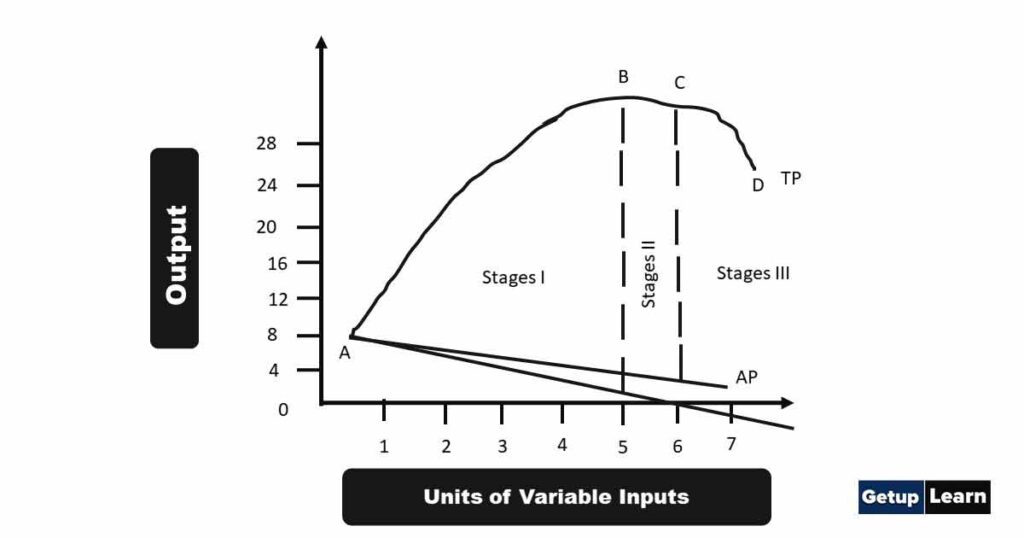
Causes of Applicability of Law of Diminishing Returns
The following are the causes of the operation of the law of diminishing returns:
- Diseconomies of Scale
- One or More Inputs are Fixed
- Imperfect Substitutes
- Beyond Optimum Combination of Inputs
Diseconomies of Scale
After a point, the internal diseconomies in the form of managerial diseconomies, marketing diseconomies, technological diseconomies and financial diseconomies creep in a business firm leading to an increase in production less than in proportion to the change in variable factors of production.
One or More Inputs are Fixed
Under short period production function, variable inputs are changed keeping one or more inputs fixed, Limited units of fixed factors and increasing units of variable inputs create an imbalance between the two and consequently, the output increases less than in proportion to change in variable inputs. It leads to the operation of the law of diminishing returns.
Imperfect Substitutes
Factors of production are not perfect substitutes. Substitution is possible to a limited extent only. After this point the change in variable inputs leads to an increase in production less in proportion and the law of diminishing returns operates.
Beyond Optimum Combination of Inputs
When the units of variable inputs are changed with the units of fixed inputs keeping constant, But after this optimum point, if more of variable inputs are employed the resultant output will be less than in proportion to the changed inputs. It will lead to the operation of law of diminishing returns.
Importance of Law of Diminishing Returns in Production
According to Professor Alfred Marshall, the scope of the law of diminishing returns was limited to agriculture only but modern economists have presented the modern version of the law and it is called the law of variable proportions.
According to this law the scope is very wide. It applies to all frontiers of production and it is universally applicable to all activities of production when variable inputs are changed by keeping fixed factors constant after the point of optimum combination of these inputs. It is the fundamental law of economics. Various economic laws are based on it. The importance of the law can be studied under the following heads:
- Fundamental Law of Economics
- Basis of Malthusian Theory of Population
- Basis of Ricardian Theory of Rent
- Basis of Marginal Productivity Theory of Distribution
- Encourages Inventions and Discoveries
- Basis of Standard of Living of People
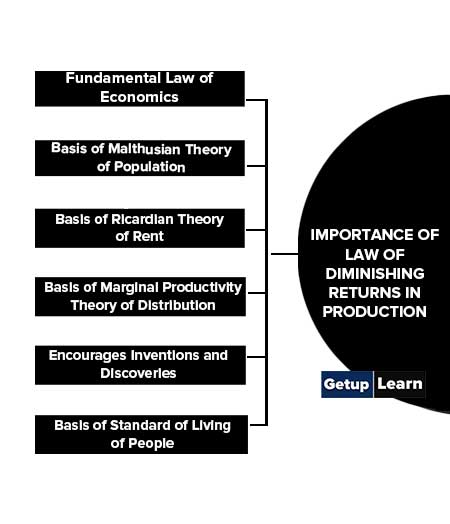
Fundamental Law of Economics
The law of diminishing returns is a fundamental law of economics. It is applicable to all frontiers of production Like agriculture, mining, manufacturing, fishing, construction of buildings etc.
Basis of Malthusian Theory of Population
The Malthusian theory of population is based on the law of diminishing returns. According to theory, the growth of population is higher than the increase in the production of food grains. The output of food grains increases at a slow rate because the law of diminishing returns applies in agriculture.
Basis of Ricardian Theory of Rent
Professor David Ricardo has also explained his theory of rent and pointed out that rent arises on account of the application of the law of diminishing returns in agriculture. It applies in intensive cultivation where the size of landholdings remain constant and variable inputs (labour and capital) are changed and after a point, the marginal product declines.
In extensive cultivation labour and capital are kept fixed and the size of landholding is changed and after a point, the marginal product declines because the law of diminishing returns operates.
Basis of Marginal Productivity Theory of Distribution
The theory of distribution is in which the share of each factor is determined on the basis of marginal productivity of a factor of production. The marginal productivity theory of distribution is also based on the law of diminishing returns. On account of it, the marginal productivity of a variable input declines.
Encourages Inventions and Discoveries
The operation of the law of diminishing returns has encouraged various inventions and discoveries in all economic activities so that the law can be postponed for some time. New techniques of production, uses of pesticides and fertilizers, high yielding varieties of seeds are some of the measures which are the result of the operation of the law which has been postponed for sometimes in agriculture
Basis of Standard of Living of People
When the growth of the population is higher than the growth of various types of resources then fewer goods and services are available to the people and consequently, the standard of living of the people will be low because of the operation of the law of diminishing returns.
Long Run Production Function
The long-run production function studies the input-output relationship during a long period. It is a period of time during which all the factors of production are variable and even the scale of production can be changed according to the demand for various goods and services by a business firm.
When all the factors of production are changed in the same proportion then the change caused in the production is called returns to scale. The long-run production function is analysed by a new technique known as the ISO-quant or ISO-product or equal product curve.
The long run is the period in which the supply of labour and capital is elastic. It implies that labour and capital are variable inputs. The long-run production function can be expressed as:
Q = f (L, K)
where (L= labour, which is variable), (K=capital, which is variable).
In the long run, inputs-output relations are studied by the laws of re- turns to scale. These are long-run laws of production. The laws of returns to scale functional can be explained with the help of the iso- quant curve, which is discussed in the next section.
What is meant by production function?
Production is a process of transforming tangible and intangible inputs into goods or services. Raw materials, land, labour and capital are the tangible inputs, whereas ideas, information and knowledge are the intangible inputs.
What is the law of constant returns in economics?
When all the productive services are increased in a given proportion, the product is increased in the same proportion.
What is the law of diminishing returns?
An increase in capital and labour applied in the cultivation of land causes in general a less than proportionate increase in the amount of produce raised unless it happens to coincide with an improvement in the art of agriculture.
What is law of variable proportion with example?
The law of diminishing returns, as it is usually formulated, states that with a fixed amount of any one factor of production successive increases in the amount of other factors will after a point, yield a diminishing increment of the product.

